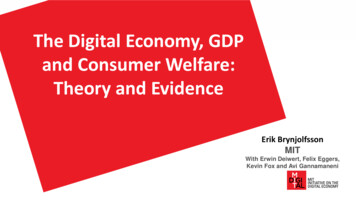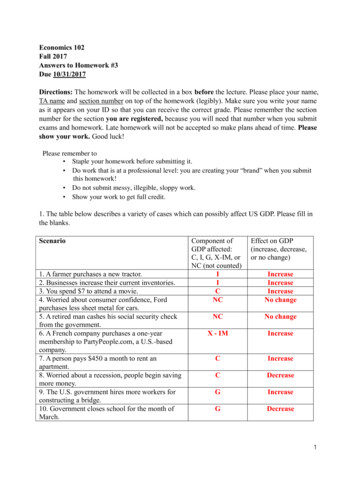
Transcription
The Digital Economy, GDPand Consumer Welfare:Theory and EvidenceErik BrynjolfssonMITWith Erwin Deiwert, Felix Eggers,Kevin Fox and Avi Gannamaneni
Challenges1. How does the digital economy affect welfare and GDP?2. Are benefits from free and new goods appropriately measured?3. Can mismeasurement help explain the productivity growthslowdown in industrialized countries?
Background There are two features of the Digital Economy that we focus onhere:1. Free goods– E.g. Facebook, Wikipedia2. New goods–E.g. Smartphones Free goods and new goods are poorly measured by GDP We introduce a new metric, we call “GDP-B” In this paper, we account for the benefits of free goods and new goods In the future, we will add other adjustments
Free Goods: Many Digital Goods and ServicesExplosion of free digital goods
Free Goods: Many Digital Goods and ServicesInformation goods as a share of GDP5.2% OF INFORMATION SECTORCONTRIBUTION TO GDPExplosion of free digital goods5.15.04.94.84.74.64.54.44.34.2YEAR
New Goods: Smartphones and Cameras Photos taken worldwide 2000: 80 billion photos 2015: 1.6 trillion photos Price per photo has gone from 50 cents to 0 cents. Increase doesn’t show up in GDP measures since. Price index for photography includes price of (film, developing, cameras)all of which are vanishing Photos are mostly shared, not sold (non-monetary transaction) GDP went down when cameras were absorbed into smartphonesRef: Varian 20175
Example: SmartphonesSmartphones substituted Camera Alarm Clock Music Player Calculator Computer Land Line Game Machine Movie Player Recording Device Video CameraPlus: Data plan GPS Map and directions Web Browser E-book reader Fitness monitor Instant messaging7
“The welfare of a nation can scarcely be inferredfrom a measurement of national income as defined[by the GDP.]”- Simon Kuznets, 1934GDP is a measure of production, not well-being8
MismeasurementDiane Coyle (2017):“The pace of change in the OECD countries is making the existing statisticalframework decreasingly appropriate for measuring the economy”Charlie Bean (2016):“Statistics have failed to keep pace with the impact of digital technology”Hal Varian (2015):“There’s a lack of appreciation for what’s happening in Silicon Valley, because wedon’t have a good way to measure it.”Chad Syverson (2017):“The productivity slowdown has occurred in dozens of countries, and its size isunrelated to measures of the countries’ consumption or production intensities ofinformation and communication technologies.”6
GDP vs. Consumer Welfare10
ΔProduction vs. ΔConsumer SurplusCase 1: Classic GoodsE.g. Automobiles, haircuts, foodGDP , Consumer Surplus 11
ΔProduction vs. ΔConsumer SurplusCase 2: Digital GoodsE.g. Increased use of free maps onsmart phones or more digitalphotos;Special case: Free digital apps thatnever existed beforeGDP no change,Consumer Surplus 12
ΔProduction vs. ΔConsumer SurplusCase 3: Transition GoodsE.g. Encyclopedia(Wikipedia vs. Britannica)Chemical photography to digitalphotographyGDP , Consumer Surplus 13
Our Empirical Approach Estimate Consumer Welfare Directly Key techniques: Online Choice Experiments and Lotteries1. Single Binary Discrete Choice Experiments2. Becker-DeGroot-Marschak Lotteries3. Best-Worst Scaling Both with and without incentive compatibility At Massive scale14
PreviewDevelop a new framework for measuring welfare change Based on the work of Hicks (1941-42), Bennet (1920) and Diewert andMizobuchi (2009)This is the foundation for a new measure we call GDP-B–1.An extension of traditional GDPDerive an explicit term for the welfare change from new goods Welfare change is mismeasured if this term is omitted by statistical agenciesDerive a lower bound for the addition to real GDP growth from a new good2.Further extend the theory allowing free goods3.Directly estimate consumer welfare by running massive online choiceexperiments Apply techniques developed by Brynjolfsson, Eggers and Gannamaneni (2016,2018)15
Empirical Implementation1. Run incentive compatible discrete choice experiments “Incentive compatible” participants risk losing access to the goodRecruit a representative sample of the US internet population via onlinesurvey panelUse data to estimate the consumer valuation of Facebook2. Quantify the adjustment term to real GDP growth (GDP-B) for thecontribution of Facebook from 2004 to 20173. Run additional incentive compatible discrete choice experiments toestimate the consumer valuation of several popular digital goods Instagram, Snapchat, Skype, WhatsApp, digital Maps, Linkedin, Twitter,and FacebookConducted in a lab in the Netherlands9
Key Empirical Findings1.2.Choice experiments generate plausible demand curves Valuations are consistent across BDM lotteries, best-worst scaling andSBDC experiments Incentive compatible experiments often imply higher valuationsMedian valuationsSearch email maps video e-commerce social media messaging music3.4.Consumer surplus from Facebook in USA: 450/year for median consumerThis approach could be scaled up to numerous goods and services17
Welfare Change and the New Goods ProblemIntroduction of a new good period 1Assume (as per Hicks 1940) there is a reservation price (aka virtual price) for thenew good that will cause the consumer to consume 0 units in period 0Let the new good be indexed by the subscript 0 and let the N dimensional vectorsof period t prices and quantities for the continuing commodities be denoted bysuperscripts: pt and qt for t 0, 1The period 0 quantity for commodity 0 is observed and is equal to 0; i.e., q00 0Period 0 reservation price is not directly observed. However, we can estimate it,denoted as p00* 010
Welfare Change and the New Goods ProblemBennet variation measure of welfare change:VB ½(p0 p1) (q1 q0) ½(p00* p01)(q01 0) p1 (q1 q0) ½(p1 p0) (q1 q0) p01q01 ½(p01 p00*)q01Terms:11
Welfare Change and the New Goods ProblemBennet variation measure of welfare change:VB ½(p0 p1) (q1 q0) ½(p00* p01)(q01 0) p1 (q1 q0) ½(p1 p0) (q1 q0) p01q01 ½(p01 p00*)q01Terms:1. p1 (q1 q0): change in consumption valued at the prices of period 111
Welfare Change and the New Goods ProblemBennet variation measure of welfare change:VB ½(p0 p1) (q1 q0) ½(p00* p01)(q01 0) p1 (q1 q0) ½(p1 p0) (q1 q0) p01q01 ½(p01 p00*)q01Terms:1. p1 (q1 q0): change in consumption valued at the prices of period 12. ½(p1 p0) (q1 q0): sum of the consumer surplus terms associatedwith the continuing commodities11
Welfare Change and the New Goods ProblemVB p1 (q1 q0) ½(p1 p0) (q1 q0) p01q01 ½(p01 p00*)q0112
Welfare Change and the New Goods ProblemVB p1 (q1 q0) ½(p1 p0) (q1 q0) p01q01 ½(p01 p00*)q013. p01q01: the usual price times quantity contribution term to the value ofreal consumption of the new commodity in period 1 which would berecorded as a contribution to period 1 GDP12
Welfare Change and the New Goods ProblemVB p1 (q1 q0) ½(p1 p0) (q1 q0) p01q01 ½(p01 p00*)q013. p01q01: the usual price times quantity contribution term to the value ofreal consumption of the new commodity in period 1 which would berecorded as a contribution to period 1 GDP4. The last term, ½(p01 p00*)q01 ½(p00* p01)q01, is the additionalconsumer surplus contribution of commodity 0 to overall welfare change(which would not be recorded as a contribution to GDP).If we assume that p00* p01, then the downward bias in the resulting Bennet measure of welfare change will beequal to a Harberger-type triangle, ½(p00* p01)q01.12
Welfare Change and the Free Goods ProblemConsumer holding Z** 0 free goods has utility u** f(x**, z**).“Global” willingness to accept (WTA) function for the disposal of z** asfollows:WA(u**, p, z**) c(u**, p, 0M) c(u**, p, z**)That is, the amount of expenditure needed to achieve the same utilitywithout access to the free good.Marginal valuation price vector w zc(u, p, z)13
Welfare Change and the Free Goods ProblemWelfare change including the free goods, and adjusting for inflation byusing γ 1 Growth Rate of CPI:VB p1 (q1 q0) ½(p1 γp0) (q1 q0) p01q01 ½(p01 γp00*)q01 w1 (z1 z0) ½(w1 γw0) (z1 z0) w01z01 ½(w01 γw00*)z01The last term is for the introduction of a new free good.14
Welfare Change and the Free Goods ProblemUnder some assumptions, can make an adjustment to real GDP growthPF PF/γ, with PF the Fisher index GDP deflator and QF a Fisher index ofGDP:GDP-B QF (γp00* p01)q01/[γp0 q0 (1 PF)] [2γw0 (z1 z0) (w1 γw0) (z1 z0) 2γw01z01] /[γp0 q0 (1 PF)] (γw00* w01)z01/[γp0 q0 (1 PF)],where the highlighted term is the contribution from new free goods. Thiswill be our focus in what follows.15
Empirics: Consumer Valuation of Facebook in US Discrete choice experiments on a representative sample of the USinternet population. Set quotas for gender, age, and US regions to match US census data(File and Ryan 2014) and applied post-stratification for education andhousehold income. Recruited respondents through an online professional panel provider,Research Now, during the year 2016-17. A total of 2885 participants completed the study including at least 200participants per price point. Disqualified participants who did not use Facebook in the previoustwelve months.16
Consumer Valuation of Facebook in US Discrete Choice Experiment1) Keep access to Facebook, or2) Give up Facebook for one month and get paid E. Allocated participants randomly to one of twelve price points:E (1, 10, 20, 30, 40, 50, 60, 70, 80, 90, 100, 1000). Informed that their decisions were consequential (incentive compatible) We would randomly pick one out of every 200 participants and fulfil thatperson’s selection. Monitored their online status on Facebook for 30 days to confirm theirchoices and make payments17
Downward-sloping WTA demand curve for FacebookThe median WTA of Facebook is 42.17/month (95% C.I.: [ 32.53; 54.47])18
Welfare Change Estimates for Facebook:Three Different Reservation Prices,½ (γw00* w01) x (No. of Facebook users in US in 2017)w00* 2w01/γEstimated 1Estimated 2Reservation Price w00*,2003 780 2,152 8,126Contribution to WelfareChange, 2017 51 billion 231 billion 1,013 billionPer year, 2017 4 billion 16 billion 72 billionPer user in 2017 18.07 81.65 358.48 253 1,143 5,018Per user over period19
GDP-B Contributions, Different Reservation Prices, Facebookw00* 2w01/γ Estimated 1Estimated 2TIReservationPrice w00*,2003 780 2,152 8,126---PercentagePoints, 200320170.341.546.760.53Per year0.020.110.480.04GDP Growthper year withoutFacebookGDP-B Growthper year withFacebook2.062.062.062.062.082.172.542.1020
Total Income (TI) MethodA simple method that doesn’t require estimation of reservation prices.Consumer has a total income (TI) that that is used to achieve the level ofutility at an observed equilibrium, t 0,1:TIt pt.xt wt.zt (market income plus imputed income), where z0 0Nominal Total Income Growth TI1/TI0Deflating this by the GDP deflator gives a quantity index. Of course, the GDPdeflator is the wrong deflator as it doesn’t take into account new free goods,which would typically mean that the deflator’s growth is too high. The resultingquantity index then provides a lower bound estimate on the actual real growthrate.33
Monthly WTA Demand Curves for Popular Digital GoodsNetherlands lab experiment; x-axis: percentage keep, y-axis: payment required21
Median WTA for Popular Free Digital GoodsServiceLaunch DateMedian WTALower CIUpper CIFacebookFebruary 2004 96.80 69.54 136.68MapsFebruary 2005 59.16 45.17 78.31October 2010 6.79 2.53 16.22SnapchatSeptember 2011 2.17 0.41 8.81LinkedInMay 2003 1.52 0.30 5.84SkypeAugust 2003 0.18 0.01 2.58TwitterMarch 2006 0.00 0.00 0.49Instagram22
Contributions to GDP-B growth in the Netherlands, percentage points(Total Income Method)TI per yearTI per year10 million2 tter0.000.00UsersService23
Scale up using Google Consumer Surveys (NIC)37
Some Implied Demand Curves and WTAWikipedia: WTAmedian 150/year38
Non-digital goods: Breakfast CerealWTAmedian 48.46/year[ 42.01, 55.60]Implied Consumer Surplus 15 billionCompare: US Cereal Revenue 10 billion
New Goods and Adjusting for Quality ChangeBDM lottery (Becker, DeGroot, and Marschak 1964) in order to estimatethe consumers’ valuation of their smartphone camera: Netherlands labAsked participants to state the minimum amount of money they wouldrequest in order to give up their smartphone camera (both main cameraand front camera) for 1 month.Participants informed that one out of 50 participants would be selected forthe lottery and that we would block their smartphone cameras with aspecial sealing tape, if their bid was successful.If, after the one month period, the seal was still intact participants wererewarded with the money and the seal could be removed.24
Incentive compatibility25
Demand Function for the Smartphone Camera26
Importance of Adjusting for Quality Change The median WTA for giving up the smartphone camera for one month is 68.13 95% CI [ 33.53; 136.78] It costs between 20- 35 to manufacture smartphone cameras present in thelatest flagship models A modular smartphone sold in the Netherlands charges 70 for adding front and back cameras Strong evidence that consumers obtain a significant amount of surplus fromusing their smartphone cameras This surplus is an order of magnitude larger than what they actually pay Therefore, even for paid goods such as smartphones, it is crucial to adjust forquality improvements before estimating GDP statistics27
Conclusions Derived new theory for the measuring welfare from new and free goods Defined a new metric: GDP-B. GDP-B provides an approximate additive adjustment to traditional GDP growth for new and freegoods. GDP-B is a lower bound on the adjustment Additional terms can be added to GDP-B as other types of welfare implications are considered Empirically implemented theory using both massive online experiments and labexperiments. Find that consumers can have very high valuations of “free” digital goods, with significantvariation over different products Estimated effects of quality change in a physical good: digital cameras in smart phones Valuations dramatically exceed the market price This emphasizes the importance of quality adjustment for goods with rapid quality change28
Closing Thoughts This line of research is still in its infancy This paper demonstrates the feasibility of implementing simpleadjustments to official data to better understand the impact ofdigital goods and services on the economy We call this GDP-B29
Project expansion Expand data collection to include: A representative sample of CPI basket of goods Most popular free digital goods Other non-market goods impacting daily life such as quality of life,fresh air, social connections, healthcare access etc. Target: 10k goods * 10 price points * 200 subjects 20 million Expand across countries and collect panel data over time Already collecting data for digital goods since 2016 in US Potential partners?46
Thank YouMIT Measuring the Economy Projecthttp://MeasuringTheEconomy.orgContact for collaborations:Erik Brynjolfsson (erikb@mit.edu)Avi Gannamaneni (avinashg@mit.edu)
Valuations are consistent across BDM lotteries, best-worst scaling and SBDC experiments Incentive compatible experiments often imply . higher. valuations. 2. Median valuations. Search email maps video e-commerce social media messaging music. 3. Consumer surplus from Facebook in USA: 450/year for median consumer . 4.











